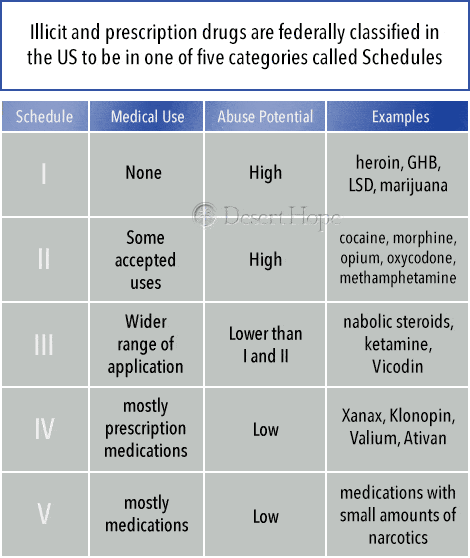Drug Schedules 1 5 Chart
The Controlled Substances Act (CSA) Title II of the Comprehensive Drug Abuse Prevention and Control Act of 1970 is the federal U.S. Drug policy under which the manufacture, importation, possession, use and distribution of certain narcotics, stimulants, depressants, hallucinogens, anabolic steroids and other chemicals is regulated. The CSA was signed into law by President Richard Nixon on October 27, 1970.
The DEA drug schedule is a list of controlled substances divided into 5 categories that differ by state. Find out what this means for pharmacists. Drug Schedules. Drugs, substances, and certain chemicals used to make drugs are classified into five (5) distinct categories or schedules depending upon the.

The addition, deletion or change of schedule of a medicine or substance may be requested by the U.S. Drug Enforcement Agency (DEA), the Department of Health and Human Services, the U.S. Food and Drug Administration (FDA), or from any other party via petition to the DEA. The DEA implements the CSA and may prosecute violators of these laws at both the domestic and international level.
One Plus 5
Within the CSA there are five schedules at the federal level (I-V) that are used to classify drugs based upon their: • abuse potential • accepted medical applications in the U.S. • safety and potential for addiction.
Individuals who order, handle, store, and distribute controlled substances must be registered with the DEA to perform these functions. They must maintain accurate inventories, records and security of the controlled substances.
The Controlled Substances Act (CSA) schedule information displayed applies to substances regulated under federal law. There may be variations in CSA schedules between individual states. Schedule 1 (I) • The drug has a high potential for abuse. • The drug has no currently accepted medical use in treatment in the United States. • There is a lack of accepted safety for use of the drug under medical supervision. NOTE: Tetrahydrocannabinol (THC, marijuana) is still considered a Schedule 1 drug by the DEA, even though some U.S.
States have legalized marijuana for personal, recreational use or for medical use. State controlled substances laws may differ for cannabinoids, for example: • In North Carolina (NC) the cannabinoids marijuana and tetrahydrocannabinols are listed as Schedule VI (with the exception of dronabinol [Marinol] which is still in schedule III).
A schedule VI substance, per NC law, is defined as 'no currently accepted medical use in the United States, or a relatively low potential for abuse in terms of risk to public health and potential to produce psychic or physiological dependence liability based upon present medical knowledge, or a need for further and continuing study to develop scientific evidence of its pharmacological effects.' • Tennessee and Arkansas also classify marijuana as a Schedule VI drug. • In Oregon, marijuana has been reclassified as a schedule II controlled substance. Schedule 2 (II) • The drug has a high potential for abuse. • The drug has a currently accepted medical use in treatment in the United States or a currently accepted medical use with severe restrictions. • Abuse of the drug may lead to severe psychological or physical dependence.
1:5 Dilution
Schedule 3 (III) • The drug has a potential for abuse less than the drugs in schedules 1 and 2. • The drug has a currently accepted medical use in treatment in the United States. • Abuse of the drug may lead to low or moderate physical dependence or high psychological dependence. Schedule 4 (IV) • The drug has a low potential for abuse relative to the drugs in schedule 3. • The drug has a currently accepted medical use in treatment in the United States. Schedule 5 (V) • The drug has a low potential for abuse relative to the drugs in schedule 4.
• The drug has a currently accepted medical use in treatment in the United States. • Drugs in schedule 5 consist primarily of preparations containing limited quantities of certain narcotics. Not controlled The drug is not subject to the Controlled Substances Act.
Drug Schedules 1 5 Charts
Sources References • US Drug Enforcement Agency (DEA). Office of Diversion Control. Controlled Substance Schedules and List of Controlled Substances. Accessed April 26, 2018 at • US Drug Enforcement Agency (DEA). Definition of Controlled Substance Schedules. Accessed April 26, 2018 at • State of North Carolina.
Schedule I Drugs
90-94 § 90-94. Schedule VI controlled substances. Accessed May 17, 2018 at Further information Always consult your healthcare provider to ensure the information displayed on this page applies to your personal circumstances.